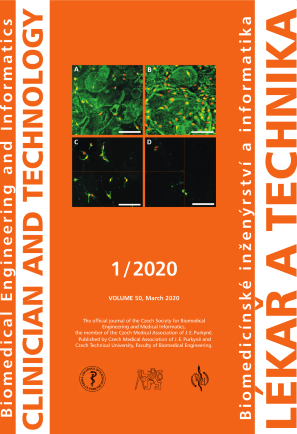FUNCTIONALIZATION OF POLYMERIC NANOFIBERS USING PLATELETS FOR MELANOCYTE CULTURE
DOI:
https://doi.org/10.14311/CTJ.2020.1.03Keywords:
nanofibers, platelets, tissue engineeringAbstract
Tissue engineering is an interdisciplinary field that uses a combination of cells, suitable biomaterials and bioactive molecules to engineer the desired tissue and restore lost function. These principles have quickly begun to spread to the therapy of multiple diseases, including depigmentation disorders. The most common depigmentation disorder is vitiligo, a disease with deep psychosocial implications. Thanks to their unique properties, electrospun polymeric nanofibers represent a material suitable for tissue engineering applications. Furthermore, they may be functionalized with platelets, cells that contain a wide spectrum of growth factors and chemokines. The aim of this paper was to evaluate the functionalization of polymeric nanofibers with platelets and their effects in melanocyte culture. The scaffolds were visualized using scanning electron microscopy, the metabolic activity and proliferation of melanocytes was determined using MTS assay and dsDNA quantification, respectively. Furthermore, the melanocytes were stained and visualized using confocal microscopy. The acquired data showed that poly-ε-caprolactone functionalized with platelets promoted the viability and proliferation of melanocytes. According to the results, such a functionalized scaffold combining nanofibers and platelets may be suitable for melanocyte culture.
Downloads
Published
Issue
Section
License
Copyright (c) 2020 Karolina Vocetkova

This work is licensed under a Creative Commons Attribution 4.0 International License.
Authors who publish with this journal agree to the following terms:
- Authors retain copyright and grant the journal right of the first publication with the work simultaneously licensed under a Creative Commons Attribution License (https://creativecommons.org/licenses/by/4.0/) that allows others to share the work with an acknowledgment of the work's authorship and initial publication in CTJ.
- Authors are able to enter into separate, additional contractual arrangements for the non-exclusive distribution of the journal’s published version of the work (e.g., post it to an institutional repository or publish it in a book), with an acknowledgment of its initial publication in this journal.
- Authors are permitted and encouraged to post their work online (e.g., in institutional repositories or on their website or ResearchGate) prior to and during the submission process, as it can lead to productive exchanges.
CTJ requires that all of the content of the manuscript has been created by its respective authors or that permission to use a copyrighted material has been obtained by the authors before submitting the manuscript to CTJ. CTJ requires that authors have not used any copyrighted material illegally, as for example a picture from another journal or book, a photo, etc. It is the author’s responsibility to use only materials not violating the copyright law. When in doubt, CTJ may ask the authors to supply the pertinent permission or agreement about the use of a copyrighted material.
The opinions expressed in CTJ articles are those of authors and do not necessarily reflect the views of the publishers or the Czech Society for Biomedical Engineering and Medical Informatics.


